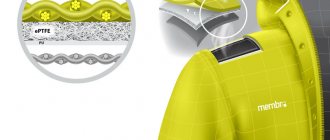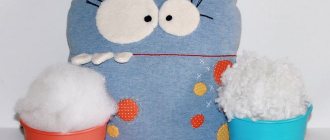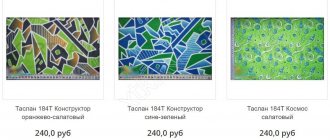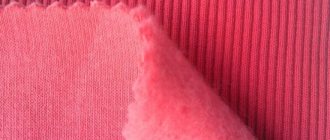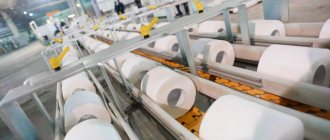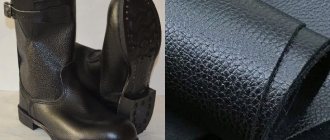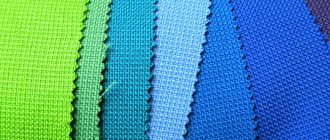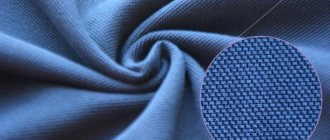What is PU leather
PU (PU, polyurethane) - all these are the names of artificial leather, which is classified as the second generation of leather substitutes. And this, of course, is not leatherette or leatherette, the properties of which we know first-hand. However, PU leather and genuine leather cannot be equated either. Although the first material is very similar to it in terms of characteristics and properties.
Before we move on to studying the features of PU leather, let’s get acquainted with the history of the appearance and development of artificial leather in our country.
A little history
Many names have been invented for substitutes for natural materials, many of which have long since taken root in our language, and we have managed to get used to them. And often, remembering that in the 90s the markets were filled with clothes made of low-quality synthetics and shoes made of low-quality leatherette, out of habit we consider everything unnatural unworthy of attention. Although the situation has long changed. And artificial is not always synonymous with low-quality.
Artificial leather has been produced on an industrial scale in the USSR since the 1930s using technology borrowed from the pulp, rubber and textile industries. The first artificial material was tarpaulin, from which boots were made for the army. The new type of leather, naturally, could not be a complete replacement for natural material, since its properties were much worse.
In search of a worthy substitute for natural leather and to preserve the lives of animals, scientists conducted new research and experiments. However, the newly obtained leatherette material was again much inferior in quality to natural leather. It was a toxic material with an unpleasant chemical smell. It did not allow air to pass through and did not absorb moisture. Nowadays this material is practically not used due to its tendency to abrasion and low wear resistance. Nevertheless, a prejudiced attitude towards artificial leather in general has been formed.
By the way, leatherette is not slang or a popular name for the material, but the real thing. It is essentially cotton fabric with a layer of nitrocellulose applied to one or both sides.
PVC leather (PVC, polyvinyl chloride) or leatherette is another type of artificial leather. It is made entirely of polymer materials. A film coating made of polyvinyl chloride with the addition of various ethereal impurities is applied to a non-woven or woven base. This makes leatherette more weather resistant. However, it accumulates moisture and does not allow air to pass through.
If a layer of PU leather is applied on top of PVC, the material becomes very similar in appearance to natural leather. Taking advantage of this, sometimes unscrupulous sellers pass it off as eco-leather.
Almost simultaneously, the Americans (in 1963) and the Japanese (in 1964) invented a material made from synthetic fiber - polyurethane. It was called eco-leather and put into production. The new type of leatherette received the prefix “eco” because polyurethane in finished products does not emit toxic substances.
The material turned out to be resistant to stretching, loads and temperature changes. Elastic, soft, without an unpleasant odor and completely unlike leatherette or leatherette. And thanks to the natural fabric base and the top layer of PU film with micropores, the artificial leather had excellent air permeability. But for all its advantages, PU leather is still an artificial product. And its composition and properties depend on the production method and technological features.
Dear Clients!
has a successful 25-year experience of working with high-quality artificial and natural leather, film materials, awning and technical fabrics, automotive and furniture fabrics on the market of Yekaterinburg and the Ural region. Over many years of work, we have acquired an extensive customer base both in Yekaterinburg and the Sverdlovsk region, as well as in neighboring regions. Most government organizations and enterprises prefer cooperation with our company to everything else. This is due to the high quality of service, a wide range and high quality of products, short delivery times, and an individual approach to each client. Our company has sufficient warehouse space, has an advantageous geographical location (both in the region as a whole and in Yekaterinburg - the city center, convenient transport interchange), regularly conducts training and staff training, and participates in seminars and exhibitions.
We represent products of Russian manufacturers, such as CJSC PO Iskozh (Neftekamsk), CJSC Ivanovoiskozh (Ivanovo); Polish products, “VINYLPEX”, “Bracia Boyakowscy”, “Mecapol”, “Tagrel”; Chinese and Turkish factories for the production of artificial leather and fabrics; Indian manufacturers of artificial leather, and many others.
The company works only with high-quality artificial and natural leathers, furniture and automotive fabrics, giving preference to premium materials. We also adhere to a high level of service, range, and quality. We have an individual approach to each client. The wide range is due to large warehouses and frequent deliveries. Yekaterinburg became the place where the company's warehouses are located - in a convenient geographical area from a regional and urban point of view.
For our customers we offer the most complete and varied range of automotive and furniture materials in the region. This includes furniture leather, automobile leather, designer leather, artificial eco-leather and many others. For furniture, we offer the widest selection of genuine leather at various prices - from economical offers to exclusive options. Please note that genuine leather is only offered in whole pieces. Each piece of leather has a mark on it that indicates the specific size of the leather. You can also use artificial leather in different directions. We supply all known types of artificial leather - PVC (vinyl leather) and PU (eco leather).
We will be glad to see you among our clients!
Types of PU leather
PU artificial material is produced in two types:
- 100% polyurethane is an artificial leather made entirely from polymer materials using a chemical method.
- Fabric with a top layer of PU coating, the production of which uses pieces and trimmings of natural hides left over from the tanning industry. In processed form, natural raw materials are applied to a polymer or fabric base and coated with polymer on top for wear resistance.
In both cases, high-grade polyurethane can be used in the manufacture of leather. Both as a filler and as a covering for defective skin. It is applied to a cotton fabric base, on which a breathable microporous film is formed. The thicker the coating layer, the better the quality of the material.
At the same time, the thickness of the coating is determined by the purpose of the skin. To sew trousers and skirts, soft elastic leather with a smaller layer of top covering is required. In the production of furniture upholstery, on the contrary, a more durable and rigid material is needed.
What is pu leather?
Eco leather, pu leather, polyurethane leather - these are all names for the same material.
Confused? Let's figure out together what characteristics this material has, find out its advantages and disadvantages and what are the differences from genuine leather and the usual leatherette to which we are accustomed. In the manufacture of bags, briefcases, backpacks, and cases, PU leather or eco-leather have recently found widespread use. Possessing excellent high-tech properties, this material is becoming increasingly popular among buyers.
PU leather is a high-tech and high-quality material. This product replicates the structure of natural leather. It is manufactured using ultra-fine fiber and high-quality polyurethane - this is a completely new technology.
PU coated material is the second and third layers of natural, defective genuine leather that has undergone special treatment with a top layer of polyurethane. It is this top layer that allows you to create artificial leather of various colors, with different patterns, but at the same time does not lose the main properties of natural leather: the ability to pass air (*breathe*) and resistance to deformation. In addition, it has a more attractive appearance than its natural counterpart. There is no need to confuse PU leather with PVC artificial leather (*leatherette*), since they are completely different in their structure, composition and properties. PVC artificial leather is made from polyvinyl chloride with plasticizers and other auxiliary components. PU leather is 1.5-2 times lighter than PVC leather, and also has better organoleptic qualities. Bags made of PU leather are more resistant to abrasion, deformation, and retain their properties even at severe subzero temperatures. The main advantage is the porous structure. This quality allows the PU-based material to *breathe*, which means that it is in this high-tech product that such hygienic indicators as breathability, vapor permeability and hygroscopicity appear.
How is polyurethane leather made?
PU fabric is a multi-layer and high-tech product. Its structure and properties resemble natural leather. The secret to obtaining a material with properties close to natural leather lies in its manufacturing technology.
The new generation material PU leather consists of several layers: base, filling and coating. The quality of PU leather directly depends on the combination and properties of the materials used in them, on the number of layers and their thickness.
The first layer (bottom) is the base. Most often, this is cotton fabric, less often - knitted or non-woven materials. The natural base, resistant to stress and stretching, makes the fabric “breathable”.
The second (middle) layer is most often a natural material treated with polymer mixtures in the form of crushed, compressed, glued together with a binder, which is applied to the first layer of the fabric base. This layer distinguishes PU leather from cheap leather substitutes.
The third layer (top) is PU coating. It consists of polyurethane applied to a base consisting of a bottom cotton layer and two or three layers of compressed defective natural material in the form of a polymer breathable film at temperatures from +130 °C to +160 °C. The name PU leather comes from the name of this polymer.
At the same stage of production, the leather is dyed, patterns and embossing are applied to it, creating a surface of different textures. In this case, the internal layers are not affected in any way. Only the top layer of the canvas, which is resistant to deformation, is processed, painted and decorated.
The three-layer “pie” technology provides the material with characteristics similar to natural leather: tensile and tensile strength, softness, frost resistance, and hygiene. In this case, no additional chemical additives are used. All the properties required for this process are already synthesized in the polymer. The polymer film does not emit anything dangerous or harmful during operation.
PU material. What is it: dermantine or leatherette?
Many people still believe that PU leather is an ordinary leatherette or dermantine. This is a completely erroneous opinion. PVC artificial leather is polyvinyl chloride, a plasticizer and some other components. But the PU material has a completely different base, in addition, it is two times lighter than leatherette. PU, from the English word polyurethane, is comparable in quality to leather, and in some properties even surpasses it. It combines the advantages of both synthetic and natural materials.
PU leather has a top coat of polyurethane, which is the most resistant to stretching and abrasion. The polymer applied to the base of the material provides a number of excellent characteristics: wear resistance, environmental friendliness, absence of cracks and stretching, resistance to low and high temperatures, softness and strength. Thanks to the through pores, the polyurethane coating is capable of allowing air to pass through, which is a very important hygienic indicator. The upper breathable and hygroscopic coating has another important property: it is hypoallergenic.
It is important to know about PU material that it is a raw material with a cotton fabric base. This makes it more resistant to stretching and mechanical stress. The most modern new technologies are used to produce microfibers and polyurethane, which are part of PU.
Material properties
Similarity to genuine leather and environmental friendliness are the main advantages of high-quality PU leather. In addition to the affordable price, eco-leather is characterized by a number of valuable properties.
- The structure of the material replicates the flexibility and plasticity of natural leather. It is lighter than artificial leather and genuine leather.
- It tolerates temperature changes well: in the cold, PU leather still remains soft and does not tan, and in the heat it does not heat up and is well ventilated through the micropores of the top layer of the film.
- Resistant to wear and mechanical stress: does not crack, tear, or stretch during wear.
- The microporous structure of the material does not prevent the skin from “breathing”. The material wicks away sweat and does not accumulate moisture. This is important in the production of shoes and clothing from PU materials.
- It does not have an unpleasant synthetic odor and does not cause irritation or allergies.
- Lightweight, elastic, soft material looks like genuine leather.
- Decorative polyurethane coating gives products fashionable shades and texture.
- PU leather is an inexpensive replacement for genuine leather products. Moreover, brands include a large number of leather products in their collections.
But just the presence of the designation “PU leather” on the label does not guarantee that all products made from it are of the same quality. To verify this, let’s compare PU leather with natural and PVC leather according to the main parameters.
What is PU Leather? What are modern bags made of?
I have asked myself this question more than once when choosing my next handbag. And this is what I found out by exploring the Internet. PU leather is a high-tech, modern material, used in the production of furniture upholstery, clothing, shoes, bags, wallets and leather goods and much more that is not related to our topic. In terms of its technical characteristics, PU leather is not inferior to natural leather, and in some properties even surpasses it. Modern technologies make it possible to imitate natural leather as much as possible and produce artificial leather of different textures, for example, embossing a reptile or python. PU leather has a smooth surface, which is not always possible to achieve in the production of natural leather.
The production of PU leather (polyurethane) consists of several stages - it is a complex, labor-intensive technological process. Depending on the purpose of the leather, cotton or other thin fabric, knitwear or non-woven materials are used as the basis. A layer of defective genuine leather that has undergone special treatment is applied to the base. Impregnated with complex polymer compositions for strength. The third layer is a polyurethane polymer, hence the name of the leather - PU leather. At this stage, the texture of the skin is formed. The result is a very durable, wear-resistant material: - environmentally friendly (odorless, does not cause allergies) - breathable (the material “breathes”) - waterproof (not afraid of moisture, does not leave dark spots when raindrops hit) - frost-resistant (withstands temperatures up to -35, does not crack or tan) - tactilely warm (does not create the impression of artificial leather) - elastic (the skin is soft, pleasant) This is only a small part of the positive qualities of leather - polyurethane.
Products made from PU leather do not require special care. If dirt appears, just wipe the item with a cloth soaked in soapy water, and the item will shine like new. If you bought a bag made of PU leather, when putting it away for storage, tightly stuff the inside with paper, put it in a fabric bag and it will retain its original appearance until the next season. Feel free to buy bags made of PU leather (press leather or eco-leather), they will serve you for several years no worse than bags made of genuine leather and will save your budget. You can see what bags and wallets made from artificially created PU leather look like on the online store website www.sumki-yes.ru.
What is the difference between PU leather and genuine leather?
PU leather, made entirely of polyurethane, imitates the structure and structure of natural material in appearance, properties and quality. There are more similarities between them than differences. Both types of leather do not change properties in the cold, maintaining plasticity and softness at sub-zero temperatures.
In terms of breathability, eco-leather is almost equal to natural leather: it “breathes” well and absorbs moisture. In terms of texture and smell, artificial leather almost completely imitates the properties of natural material thanks to fragrances and special processing. The PU material, depending on the base, is not inferior in elasticity to its natural counterpart, which stretches well without tearing.
At the same time, PU leather is a more durable and wear-resistant material. Genuine leather becomes abraded over time. The artificial analogue is more resistant to ultraviolet radiation, chemicals, high temperatures and does not form abrasions. Another advantage of PU leather is its price. Products made from this material are several times cheaper than those made from genuine leather.
Signs by which you can distinguish genuine leather from PU leather
It is very difficult to distinguish high-quality PU leather from natural leather by external signs. It will be just as warm when you touch it and will smell just like natural. If you drop a few drops on the material, natural leather, like PU leather, will immediately absorb it and darken. But if the fabric base is visible on the cut, this is a sign that the leather is artificial. In addition, the cut edge of genuine leather is slightly thicker.
You can navigate by the label, which contains information about the lining and base of the product. But here you need to learn to understand what this or that marking on the tag means. For example, the sign “skin with a diamond” shows that the clothing is made from defective natural fabric coated with polyurethane. The diamond-shaped sign indicates an artificial analogue. The hash mark is an indicator of the textile composition.
What is eco leather, PU leather
The article was compiled based on materials from the sites: hvastik.com and vidy-tkanej.ru
Eco leather: what is it? Leatherette, artificial leather or genuine leather? Buyers often ask these questions when they see products made from this very beautiful material. Their mistrust is understandable, because, as a rule, artificial leather is always worse than the original, and, regardless of appearance, eco-leather raises many doubts about its quality, strength and service life.
Eco-leather: history of origin
To preserve the lives of animals, in search of an alternative to natural leather, experiments began on the production of its analogues. Scientists have been conducting research for a long time and trying to find a worthy substitute for it, but, alas, there was no proper result. Leatherette was very much inferior in quality, which is why a prejudiced attitude appeared towards the artificial analogue of leather. Research did not stop being carried out, and scientists in the USA in 1963 (Japan - in 1964) invented a material that was unique in its properties, practically not inferior to the original, an analogue began to be called eco-leather. It was obtained on the basis of polyurethane, i.e. synthetic fiber. Artificial material was put into production, and its replacement of natural leather made it possible to significantly reduce the number of animals subject to killing.
PU (PU) leather: what is it
It is not uncommon to find in descriptions of bags, jackets and other leather and leatherette products that the leather in this product is PU. The first thing that comes to a potential buyer’s mind is that this bag is made of cheap leatherette or leatherette. But for some reason, even famous manufacturers do not shun the use of PU leather in their products, and often advertise this fact as an advantage. Confusion of concepts also arises, what is the difference between: PU (PU) leather PVC (PVC) leather Eco-leather Press leather Cheap “Soviet” leatherette
Genuine leather, in our usual understanding, is whole animal skin, cleaned and processed in a certain way. Artificial leather can be very different. But conditionally it can be divided into two groups:
- completely artificial leather, which is made entirely from polymer materials, possibly using a woven base
- artificial leather using tannery waste, when waste from processing natural leather (trimmings, leather dust) is crushed, pressed and glued into a single piece
Polymer materials such as polyurethane, polyvinyl chloride, nitrocellulose can be used in the manufacture of any leather. Both with and without genuine leather content. Moreover, polyurethane can also be used as a coating for natural, but not very high-quality leather.
Artificial leather is produced entirely chemically without the use of tannery waste. The quality of such completely artificial leather depends on the materials used. That is, it depends on what kind of polymer is used: PVC, PU or nitrocellulose. And also on the base material, number of layers and coating.
Artificial leather from tannery waste. Also sometimes this kind of leather can be called Presskozha. Tannery waste is crushed and placed in a chemical paste for bonding, after which such leather can be applied to a polymer or woven base and coated with a polymer for wear resistance.
In some cases, the manufacturer may call such material genuine leather. However, it is not. Pressed leather is no better than completely artificial leather and, of course, it is absolutely not genuine leather. A lot of chemical mixtures are used in its production; it is not environmentally friendly and is allergenic. Such leather does not breathe well, and without a high-quality base and coating it quickly becomes unusable.
If you compare pressed leather and modern PU leather, it is better to prefer PU leather. PU (PU, PUR) is a polymer Polyurethane (Polyurethane), an artificial material obtained as a result of certain chemical processes. Due to its properties, polyurethane is widely used in industry. Depending on the manufacturing method (formulas, ingredients), polyurethane has different mechanical and temperature characteristics. But in general it is very resistant to wear and temperature changes. In general, polyurethane does not lose its specified properties in the temperature range from -60 to +80 degrees Celsius. A distinctive feature of polyurethane is the ability to create a porous material that can breathe and remove moisture. This is especially important when making clothes and shoes from PU materials. However, you need to understand that just the presence of the phrase “PU leather” does not mean that this leather breathes. On the other hand, high-quality, fully artificial PU leather has a number of positive characteristics:
extremely wear-resistant
allows water to pass through (wicks away sweat)
tactilely similar to natural leather
does not burst in the cold
no chemical odors
not allergenic
Based on the above, we can draw the following conclusion: artificial PU leather is good. This is a high-quality material that can be preferred to genuine leather.
What is Eco-leather:
Eco-leather is a colloquial, marketing name for PU leather.
How does PU leather differ from PVC (PVC) leather PVC (PVC, PolyVinyl Chloride) is ordinary plastic in its plastic form. PVC-based leatherette is a flexible plastic attached to a woven or non-woven base. Hard, rough, but cheap and durable. PVC leather is still widely used in the manufacture of various products. Often, a layer of PU leather is applied to the outer layer of PVC leather, resulting in the tactile sensation of PU leather, but cheaper. What is dermatin? This is not a popular name, not slang, but the real name of the material. In fact, it is a fabric with a layer of nitrocellulose applied to it. Nowadays this material is practically not used due to its extremely low wear resistance. Everyone who lived in the USSR remembers the worn leatherette tables and chairs. It is because of this tendency to abrasion that they abandoned the use of leatherette.
Comparison of PU leather with PVC leather
Cheap leatherette and polyurethane leather differ greatly in properties. This is due to the technology of their production and depends on the chemical compounds used.
PVC leather is inferior to PU leather in many respects:
- plastic (polyvinyl chloride) in the base, hidden under a layer of top PU or PVC film, is toxic and can cause allergies;
- makes products hard in the cold, breaks and becomes tanned, while products made from PU leather retain their properties from -20 to +80 °C.
- leatherette - the material is inelastic and inferior in service life, over time it delaminates and cracks;
- PVC leather is cold to the touch, with a pungent chemical odor;
- PVC film does not allow air to pass through and does not absorb moisture - this is its main disadvantage and its difference from high-strength and frost-resistant polyurethane with breathability at the level of its natural counterpart;
- The only advantage of leatherette is that it is cheaper than PU leather.
How to distinguish natural material and PU leather from low-quality leatherette
The material will not heat up when you touch it with your hand. It will not absorb a drop of water applied to it due to the fact that it does not allow moisture to pass through. It will smell like synthetics and plastic. If the leather shows signs of delamination, then it is not PU leather or natural.
What is recycled (pressed) leather and how is it different from natural leather?
Recycled leather - pu leather (bonded leather, reconstituted leather) - a cheaper analogue of natural leather. In its production, scraps of natural leather, leather shavings, thermoplastic resins and artificial fibers are used: polyethylene, polyesters, polyamide.
The pieces of skin remaining after cutting and processing are crushed and turned into “leather” flour. A binder material is mixed into the fibrous powder. The finished mixture of synthetic and natural fibers is melted. As a result, all components combine and, after cooling, a substance is obtained that feels and smells like leather.
In terms of properties, pressed leather cannot be equated to natural material. Since chemical components are used in its production. It is not superior in quality to artificial PU leather.
The material allows water to pass through (critical for shoes), but does not allow air to pass through. The structure of the canvas without a high-quality coating and base quickly collapses. When comparing modern PU leather and pressed leather, the advantages are on the side of the former.
By what signs can you distinguish pu leather from natural leather:
- press leather base – fabric or non-woven fiber;
- the surface of the canvas is uniform, smooth;
- there is a specific chemical smell;
- the material is cold to the touch and does not adjust to body temperature;
- When heated, it melts, releasing a pungent chemical odor.
Saffiano leather – natural material or not?
Initially, saffiano is genuine leather. According to the definition:
Saffiano leather is a textured calfskin that is resistant to stains and scratches.
It is thanks to its texture with diagonal fine embossing that the material acquires high strength and resistance to abrasion and scratches. On the other hand, such a finish makes it look like leatherette. The rough surface is not as pleasant to the touch, and, according to some people, it looks “cheap”.
Please note that natural saffiano leather is often counterfeited. An explosion of popularity in 2012 gave rise to the production of materials with a similar texture. In this regard, many began to distinguish the morocco effect:
If the material simply says “Saffiano”, it means it has been hot stamped (a “ribbed” or other pattern has been applied).
By the way, similar embossing can be seen on the covers and bindings of books. This is not genuine leather, but a polyvinyl or polyamide substitute (lederin or other).
What is special about polyurethane coated leather?
In this case, the polyurethane coating is applied not to a fabric base, as in eco-leather, but to natural animal skins with any defects or improperly processed. The polyurethane top layer solves two problems: a painted decorative PU coating with characteristic embossing corrects flaws in the natural material and at the same time preserves the properties of the natural base in the product.
Description of saffiano leather
Saffiano leather, common these days, has Italian roots. The patent for "Saffiano" belongs to the world famous brand "Prada". Back in 1913, the company released a handbag with a specific branded embossing. Photo:
The interesting texture added originality and practicality to the bags. The morocco surface does not scratch or wear off. Leather products can last 10 years or more, maintaining an excellent appearance. Even then the material was appreciated. Bags, wallets, and other leather goods were made from it.
But the real “morocco boom” came in 2012, when global brands unanimously released a series of accessories with characteristic embossing. Love Moschino, DKNY, Michael Kors handbags immediately found a response in women's hearts. They were dreamed about, wanted, and bought en masse by women of all ages.
What is sewn from PU fabric
An artificial material made of polyurethane with a decorative surface reminiscent of luxury expensive leather is used by designers to realize their ideas in many industries: in interior design, in the manufacture of various accessories, furniture, and clothing.
They sew from PU leather:
- shoes;
- women's and men's jackets and other outerwear;
- gloves and belts;
- purses and wallets;
- covers for phones, laptops, cameras;
- bracelets for wristwatches;
- suitcases, bags and backpacks;
- upholstery for furniture and cars;
- sporting goods: knee pads, protective masks, balls, gloves, helmets.
Material PU (PU) - what kind of fabric is it: description
What kind of PU material is this, do you know? If you have seen these letters on labels more than once, but have not yet figured out what they mean, read our article! We will tell you what PU fabric is, in what areas it is used, and what features it is characterized by. We guarantee you will find out all the necessary information.
Features and Specifications
Few people know what it is - PU material, although this designation has firmly penetrated the market of modern products. Many buyers confuse it with dermantine or leatherette, but this is not entirely true. Let's discuss in detail what kind of material PU leather is - it is a high-grade polyurethane polymer that imitates the structure and structure of natural material. Innovative, high-tech polyurethane has the best characteristics.
There is a full-fledged PU composition, and there is only PU upper material - what does this mean, what is the difference?
It's time to talk about what the composition of PU fabric is and pay special attention to it.
- The top layer is polyurethane applied to the base;
- The basis is two or three layers of natural defective material that has been processed;
- One of the layers is genuine compressed leather;
- The base is cotton material
Only the top layer of the product is painted, decorated and processed! The inner layers are not affected during manufacturing. Useful: PVC - what kind of material this is can be read in another article.
You already know what this means – PU material. Let us note the advantages with which it is characterized:
- Resistance to low and high temperatures;
- Light weight;
- Softness;
- Air permeability;
- Environmentally friendly production;
- High elasticity;
- The material does not crack;
- Differs in vapor permeability;
- Does not accumulate moisture;
- Does not have an unpleasant odor;
- Resistant to mechanical stress.
It is important to note that the coating is not hypoallergenic, regardless of the manufacturer’s assurances. It is impossible to achieve this indicator.
We found out what this means – the main material is PU on the tag. You can buy such things without fear; they are distinguished by their quality, comfort to wear, and excellent external characteristics. You can find out what polyamide fabric means by following the link.
Areas of use
We discussed above, 100 PU - what kind of fabric it is, why it is needed. It's time to find out what purposes it is used for. The characteristics of the material allow it to be successfully used in various fields - it is especially appreciated by designers. The surface leaves room for a variety of design ideas!
Most often PU leather is used:
- For watch straps;
- For covers of mobile devices, cameras, laptops;
- For sewing jackets and down jackets;
- For women's and men's bags, wallets;
- For shoes - both surfaces and soles. These can be boots, sneakers, ballet shoes and much more.
It is the ability to “breathe”, not accumulate moisture and ease of care that are the defining qualities that have made the canvas so popular. By the way, we must not forget about the cost - every buyer will like it. This type of fabric is accessible and cheap compared to natural counterparts.
Additionally: We'll tell you how often you need to change your bed linen.
We touched on the production of clothing, shoes and accessories. Don't forget that raw materials are used in the production of wheels, travel accessories, and outdoor products.
Shall we say a few words about leaving? Helpful tips should help you with daily wear:
- To remove dirt, use a soft damp cloth;
- Don't forget to wipe wet marks dry with a soft cloth;
- Use water-repellent impregnations;
- Ammonia or a natural fabric cleaner will help remove difficult stains.
There are no more secrets left, what the mysterious abbreviation means, we figured it out in the most detailed way. You can safely choose a similar fabric for a bag or sneakers - we guarantee you will enjoy the quality for many years.
Read further: Struttofiber - let's talk about this filler in the mattress.
Advantages and disadvantages
Reasonable price, appearance and properties of genuine leather - all this, of course, appeals to buyers in polyurethane leather. Noting the advantages of modern artificial material in reviews, many highlight such qualities as softness, lightness, elasticity of the material, and comfort for the body. The price is quite satisfactory, which means you can please yourself with new things and update the interior more often.
Among the reviews there are also negative ones. For example, it is very difficult to get rid of pet scratches if they appear on polyurethane products. Furniture upholstery made from this material is also easy to ruin if there are small children in the house who like to paint wallpaper, tables and furniture with paints and felt-tip pens.
If clothes are made from cheap leather, they are not very comfortable in cold weather.
How to care for eco leather
Products made from high-quality eco-leather can replace shoes and jackets made from natural materials. However, you need to care for them as carefully as for products made from genuine leather.
To remove minor stains, simply wipe the stain with a soft, damp cloth, then dry.
It is recommended to clean stains of organic origin with products intended for natural leather, following the instructions.
To improve the water-repellent properties of the product and extend its service life, it is recommended to treat the leather with special impregnations for natural clothing and shoes.
Answering the question: is PU leather synthetic or a natural product? We can say that it is an artificial material. Despite the partial content of processed natural leather, its production still uses high-tech chemical processes.
